 The Tale of the HeikeAlso translated by Royall TylerThe Tale of GenjiThe TALE of the HEIKETranslated by
The Tale of the HeikeAlso translated by Royall TylerThe Tale of GenjiThe TALE of the HEIKETranslated by ROYALL TYLER VIKING VIKING Published by the Penguin Group Penguin Group (USA) Inc., 375 Hudson Street, New York, New York 10014, U.S.A. Penguin Group (Canada), 90 Eglinton Avenue East, Suite 700, Toronto, Ontario, Canada M4P 2Y3 (a division of Pearson Penguin Canada Inc.) Penguin Books Ltd, 80 Strand, London WC2R 0RL, England Penguin Ireland, 25 St. Stephens Green, Dublin 2, Ireland (a division of Penguin Books Ltd) Penguin Books Australia Ltd, 250 Camberwell Road, Camberwell, Victoria 3124, Australia (a division of Pearson Australia Group Pty Ltd) Penguin Books India Pvt Ltd, 11 Community Centre, Panchsheel Park, New Delhi110 017, India Penguin Group (NZ), 67 Apollo Drive, Rosedale, Auckland 0632, New Zealand (a division of Pearson New Zealand Ltd) Penguin Books (South Africa) (Pty) Ltd, 24 Sturdee Avenue, Rosebank, Johannesburg 2196, South Africa Penguin Books Ltd, Registered Offices: 80 Strand, London WC2R 0RL, England First published in 2012 by Viking Penguin, a member of Penguin Group (USA) Inc. 10 9 8 7 6 5 4 3 2 1 Translation, introduction, and notes copyright Royall Tyler, 2012 All rights reserved Illustrations by Teisai Hokuba from
Heike monogatari zue, text by Takai Ranzan, published in Japan in two parts, in 1829 and 1849 LIBRARY OF CONGRESS CATALOGING-IN-PUBLICATION DATA Heike monogatari. English. p. cm. cm.
ISBN: 978-1-101-60109-9 1. Taira familyFiction. 2. JapanHistoryGempei Wars, 11801185Fiction. I. II. Title. Title.
PL790.H4E5 2012 895.632dc23 2012000598 Printed in the United States of America Designed by Carla Bolte Set in Adobe Warnock Pro with Adobe Charlemagne display Genealogies and maps by Jeffrey L. Ward No part of this book may be reproduced, scanned, or distributed in any printed or electronic form without permission. Please do not participate in or encourage piracy of copyrighted materials in violation of the authors rights. Purchase only authorized editions. 

ACKNOWLEDGMENTS

I am grateful first to Michael Watson, who suggested the format for the translation, showed me where to find the required performance information, and helped me to obtain the source work for the illustrations. Tom Conlan, whose love of
Heike monogatari provided enduring moral support, advised me on many matters from a historians perspective.
Alison Tokita, Hugh de Ferranti, and Komoda Haruko provided information on music and performance. Susan Tyler proofread and edited successive drafts, meanwhile making valuable comments from her own knowledge of medieval Japan. I am grateful to them all. Wendy Wolf, my editor, is by now an old friend to whom I owe more than I can say. It is a pleasure also to thank, for their skill and enthusiasm, the whole Viking Penguin team: Bruce Giffords, the production editor; Carla Bolte, the designer; Maureen Sugden, the copy editor; Paul Buckley, the jacket designer; and others whose names and functions I do not know but who also played their part in making this book what it is.

INTRODUCTION

R ichly varied in incident and mood,
The Tale of the Heike (
Heike monogatari) tells of a tyrants cruelty and overweening pride, his death, and the ultimate destruction of his house.
No work of Japans classical literature influenced more pervasively the art, literature, and drama of later centuries. Heike is a seminal masterpiece of Japanese culture. The tyrant was Taira no Kiyomori (111881). Heike, pronounced hay-keh, means Taira house, especially (although not exclusively) Kiyomoris extended family. In his time the Heike lorded it over their great rivals, the Genji (Minamoto house), and it is the Genji who rose up in the end to destroy them. The Genji leader Minamoto no Yoritomo (114799), another major figure in Japanese history, looms from a distance over the later sections of the work.
The events related in the tale, with some dramatic license, convulsed late-twelfth-century Japan and left indelible cultural memories. Formal records confirm them in outline and often in detail, and knowledge of the historical background (see H gen and Heiji, below) helps to explain the storys force. Heike could be said to dramatize history as collectively experienced by the tales original audience and their recent forebears. It also answers a deep urge to pacify, by telling their story, the threatening spirits of the bitter, defeated Heike dead. An earlier masterpiece, The Tale of Genji (early eleventh century), left Japan an atmosphere of beauty and elegance that still enthralls countless readers. The legacy of The Tale of theHeike consists especially of dramatic episodes, touching or tragic.
gen and Heiji, below) helps to explain the storys force. Heike could be said to dramatize history as collectively experienced by the tales original audience and their recent forebears. It also answers a deep urge to pacify, by telling their story, the threatening spirits of the bitter, defeated Heike dead. An earlier masterpiece, The Tale of Genji (early eleventh century), left Japan an atmosphere of beauty and elegance that still enthralls countless readers. The legacy of The Tale of theHeike consists especially of dramatic episodes, touching or tragic.
The most famous of these is perhaps the encounter of Kumagai and Atsumori (9:16). Others relate the trials of the dancers Gi (1:6) and Kog
(1:6) and Kog (6:4), the exiled Shunkans despair (3:2), the extravagant austerities of the monk Mongaku (5:7), the burning of the great temples of Nara (5:14), the deaths of Kiso no Yoshinaka and Kanehira (9:4), Yoshitsunes dazzling victory at Ichi-no-tani (9:12), and Nasu no Yoichis exploit at Yashima (11:4). These and many others inspired centuries of theater (Noh, Bunraku, Kabuki) and visual art (painting, prints), followed more recently by film, television, modern retellings, manga, and warrior fantasies of all kinds. Awareness of transience, often cited as a governing theme in Japanese literature, received its most famous statement in the tales opening lines. AUTHORSHIP AND TEXTS Who wrote The Tale of the Heike? Essays in Idleness (Tsurezure-gusa, circa 1330, by Yoshida Kenk
(6:4), the exiled Shunkans despair (3:2), the extravagant austerities of the monk Mongaku (5:7), the burning of the great temples of Nara (5:14), the deaths of Kiso no Yoshinaka and Kanehira (9:4), Yoshitsunes dazzling victory at Ichi-no-tani (9:12), and Nasu no Yoichis exploit at Yashima (11:4). These and many others inspired centuries of theater (Noh, Bunraku, Kabuki) and visual art (painting, prints), followed more recently by film, television, modern retellings, manga, and warrior fantasies of all kinds. Awareness of transience, often cited as a governing theme in Japanese literature, received its most famous statement in the tales opening lines. AUTHORSHIP AND TEXTS Who wrote The Tale of the Heike? Essays in Idleness (Tsurezure-gusa, circa 1330, by Yoshida Kenk ) identifies the author as one Yukinaga. This Yukinaga taught a blind man named Sh
) identifies the author as one Yukinaga. This Yukinaga taught a blind man named Sh butsu to perform what he had written; then Sh
butsu to perform what he had written; then Sh butsu expanded the work on his own and had Yukinaga write his additions down.
butsu expanded the work on his own and had Yukinaga write his additions down.
Nothing else confirms this account, and the development of the tale as we have it clearly followed a longer and more complicated path than that, but the passage is suggestive. For one thing, this reported give-and-take between an educated writer and a blind performer indicates an interplay between written and oral origins that is visible both in the character of surviving Heike texts and in the relationship between the work and its audience. Many versions of Heike survive. Some are shorter, some longer. They fall under two headings: those to be read (yomihon) and those to be performed (kataribon

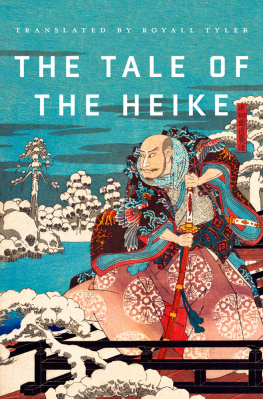
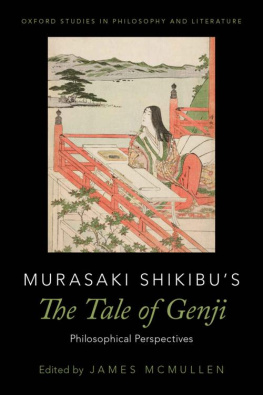

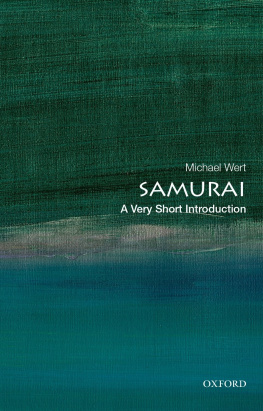

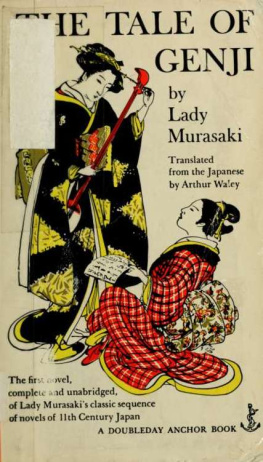
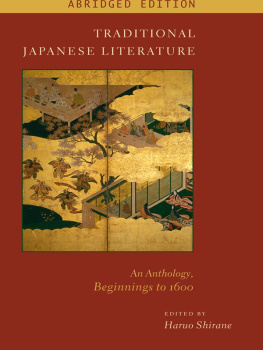
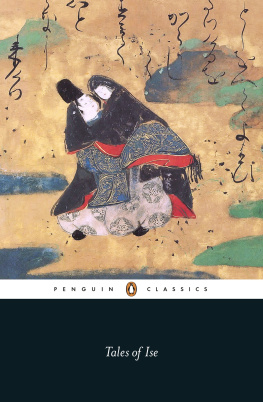
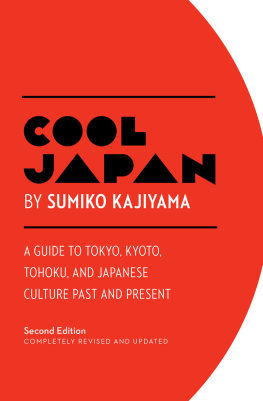
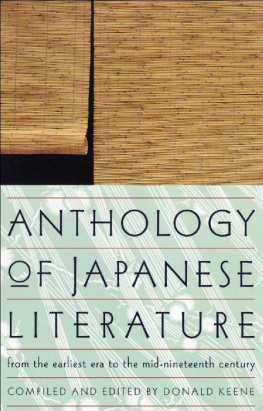
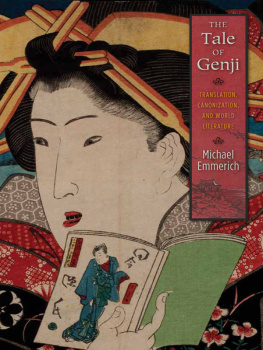

 The Tale of the HeikeAlso translated by Royall TylerThe Tale of GenjiThe TALE of the HEIKETranslated by ROYALL TYLER VIKING VIKING Published by the Penguin Group Penguin Group (USA) Inc., 375 Hudson Street, New York, New York 10014, U.S.A. Penguin Group (Canada), 90 Eglinton Avenue East, Suite 700, Toronto, Ontario, Canada M4P 2Y3 (a division of Pearson Penguin Canada Inc.) Penguin Books Ltd, 80 Strand, London WC2R 0RL, England Penguin Ireland, 25 St. Stephens Green, Dublin 2, Ireland (a division of Penguin Books Ltd) Penguin Books Australia Ltd, 250 Camberwell Road, Camberwell, Victoria 3124, Australia (a division of Pearson Australia Group Pty Ltd) Penguin Books India Pvt Ltd, 11 Community Centre, Panchsheel Park, New Delhi110 017, India Penguin Group (NZ), 67 Apollo Drive, Rosedale, Auckland 0632, New Zealand (a division of Pearson New Zealand Ltd) Penguin Books (South Africa) (Pty) Ltd, 24 Sturdee Avenue, Rosebank, Johannesburg 2196, South Africa Penguin Books Ltd, Registered Offices: 80 Strand, London WC2R 0RL, England First published in 2012 by Viking Penguin, a member of Penguin Group (USA) Inc. 10 9 8 7 6 5 4 3 2 1 Translation, introduction, and notes copyright Royall Tyler, 2012 All rights reserved Illustrations by Teisai Hokuba from Heike monogatari zue, text by Takai Ranzan, published in Japan in two parts, in 1829 and 1849 LIBRARY OF CONGRESS CATALOGING-IN-PUBLICATION DATA Heike monogatari. English. p. cm. cm.
The Tale of the HeikeAlso translated by Royall TylerThe Tale of GenjiThe TALE of the HEIKETranslated by ROYALL TYLER VIKING VIKING Published by the Penguin Group Penguin Group (USA) Inc., 375 Hudson Street, New York, New York 10014, U.S.A. Penguin Group (Canada), 90 Eglinton Avenue East, Suite 700, Toronto, Ontario, Canada M4P 2Y3 (a division of Pearson Penguin Canada Inc.) Penguin Books Ltd, 80 Strand, London WC2R 0RL, England Penguin Ireland, 25 St. Stephens Green, Dublin 2, Ireland (a division of Penguin Books Ltd) Penguin Books Australia Ltd, 250 Camberwell Road, Camberwell, Victoria 3124, Australia (a division of Pearson Australia Group Pty Ltd) Penguin Books India Pvt Ltd, 11 Community Centre, Panchsheel Park, New Delhi110 017, India Penguin Group (NZ), 67 Apollo Drive, Rosedale, Auckland 0632, New Zealand (a division of Pearson New Zealand Ltd) Penguin Books (South Africa) (Pty) Ltd, 24 Sturdee Avenue, Rosebank, Johannesburg 2196, South Africa Penguin Books Ltd, Registered Offices: 80 Strand, London WC2R 0RL, England First published in 2012 by Viking Penguin, a member of Penguin Group (USA) Inc. 10 9 8 7 6 5 4 3 2 1 Translation, introduction, and notes copyright Royall Tyler, 2012 All rights reserved Illustrations by Teisai Hokuba from Heike monogatari zue, text by Takai Ranzan, published in Japan in two parts, in 1829 and 1849 LIBRARY OF CONGRESS CATALOGING-IN-PUBLICATION DATA Heike monogatari. English. p. cm. cm. 
 ACKNOWLEDGMENTS
ACKNOWLEDGMENTS 
 gen and Heiji, below) helps to explain the storys force. Heike could be said to dramatize history as collectively experienced by the tales original audience and their recent forebears. It also answers a deep urge to pacify, by telling their story, the threatening spirits of the bitter, defeated Heike dead. An earlier masterpiece, The Tale of Genji (early eleventh century), left Japan an atmosphere of beauty and elegance that still enthralls countless readers. The legacy of The Tale of theHeike consists especially of dramatic episodes, touching or tragic.
gen and Heiji, below) helps to explain the storys force. Heike could be said to dramatize history as collectively experienced by the tales original audience and their recent forebears. It also answers a deep urge to pacify, by telling their story, the threatening spirits of the bitter, defeated Heike dead. An earlier masterpiece, The Tale of Genji (early eleventh century), left Japan an atmosphere of beauty and elegance that still enthralls countless readers. The legacy of The Tale of theHeike consists especially of dramatic episodes, touching or tragic.